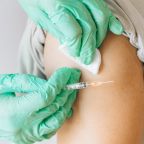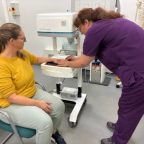
Non-existent awareness of leukaemia symptoms “extremely worrying”
Leading UK leukaemia charities launch memorable new campaign to get people “parroting on” about the symptoms for Blood Cancer Awareness Month in September
People in the South West are being urged to take notice of the symptoms of leukaemia, as new research published today shows that none of those surveyed in the region were able to identify ALL four of most widely reported symptoms - fatigue, bruising, unusual bleeding and repeated infections.
Leukaemia is a form of blood cancer affects people of all ages and 28 people receive a leukaemia diagnosis every day in the UK – that’s over 10,000 every year. Overall survival for leukaemia stands at just over 50% - making it one of the most deadly forms of cancer.
Early diagnosis could saves lives, yet the recent public survey by leukaemia charities Leukaemia UK and Leukaemia Care, found that over that a third (33%) of respondents from the South West could not recognise ANY amongst the four most widely reported symptoms of the disease, which kills 5,000 people a year in the UK, and which is often diagnosed too late.
The two charities are collaborating on an important campaign, #SpotLeukaemia, to raise awareness of the symptoms ahead of Blood Cancer Awareness Month in September. Blood cancer is the fifth most common cancer and third deadliest.
In a new film released today Leukaemia Care and Leukaemia UK have called on the expertise of ‘Henry’, a talented Macaw parrot, to try to make the symptoms of leukaemia memorable. The ad sees Henry using a range of objects to create a catchy and repetitive ‘Spot Leukaemia rap’ featuring the symptoms of leukaemia.
People who are concerned about any of these symptoms - fatigue, bruising, unusual bleeding and repeated infections – are being strongly urged by the charities to contact their GP and request a blood test. More information is available on the Spot Leukaemia website at www.spotleukaemia.org.uk.
The ad focuses on the top four symptoms. Other symptoms of leukaemia include fever or night sweats, bone or joint pain and swollen lymph nodes.
The charities are now calling on people to start “parroting on” about leukaemia and its symptoms, share the video (https://youtu.be/UMRTMKVvYhQ) with friends and family, and visit the Spot Leukaemia website for more help and advice.
Awareness of the symptoms of leukaemia is low in the South West
Only 13% of respondents across the East recognised that repeated infections - one of the most common symptoms of leukaemia - are a symptom, only 31% said unusual bruising is a symptom and only 13% said unusual bleeding is a symptom. Only 54% of respondents were not able to recognise fatigue as a symptom – which is often the most likely symptom to be identified by those later diagnosed with leukaemia.
Geoffrey Brown, 69, a retired Aircraft Engineer from Swindon, was diagnosed with chronic lymphocytic leukaemia (CLL) completely out of the blue after a routine NHS health check flagged up an abnormal blood test.
“The first inkling that something was wrong was after attending a NHS local community health screening in February 2016. The result of a quick blood test gave the nurse cause for concern, so I was told to visit my GP.
This I duly did and after some considerable time involving further GP visits and more blood tests with the GP led to my first appointment with a Haematology consultant in June 2016. This involved more bloods and a pelvic bone core sample for further investigation. This occurred over a two day period., I was finally diagnosed with B-cell chronic lymphocytic leukaemia (CLL) on the 4th August 2016. I had experienced no symptoms whatsoever during the build up to my diagnosis.
August 2016 I was finally given the 'good news' along with the fact I had a TP53 mutation which precluded me from Chemotherapy. Subsequently placed on 'watch & worry' until August 2018 when my condition had deteriorated enough to start treatment. As my blood counts were not too serious at the time, I was discharged from the GWH on ‘watch and wait’ with six-monthly blood tests.
Now I have read that the term ‘watch and wait’ really means ‘watch and worry’. I did not see a problem with my diagnosis, I was not presenting with any of the usual symptoms, so I was determined to continue my lifestyle until I no longer could. So, life continued as normal – four miles jogging every day, holidays, motorsport, DIY, you name it.
As I retired early I became a ‘non practicing’ Aircraft Engineer, but still having a head for figures I could see by the results of my first two blood tests that I could extrapolate when I would have to reduce my lifestyle and have treatment.
My calculations of August 2018 were correct and the result of my blood tests in August of that year caused so much concern to my GP that I was in the practice at 15:00 on the 13th August and attending the Ambulatory Care Unit of GWH by 16:00!
The Haematology Department received the news of my arrival whereupon I was told to report there immediately. So, the last few hours of the working day were having blood tests and chatting to the duty consultant. I was then told to go home, with cannula still in place, and report back at 08:30 the next day. I duly arrived at the specified time and during the day I underwent further blood tests until my arms ran out of room to give blood; a very, very thorough physical examination; a long discussion about myself and the warning not to jog four miles or even walk too briskly. After lunch and more blood tests, a bone marrow biopsy was carried out which I found to be totally painless and nothing like all the horror stories that you hear and read about.
During the rest of August while awaiting in depth analysis of the bone marrow and blood samples, I had a CT scan of the neck, abdomen and thorax followed some days later by a cardio echo.
The 4th September 2018, World Leukaemia Day, was the big day. My wife and I attended the Haematology department for all the results: lymph nodes were slightly swollen, my spleen was slightly enlarged, and I was very anaemic, but my heart was OK. And the really good news (not) was that I have the TP53 mutation which means no chemotherapy but I will be, as an outpatient, taking 420mg of ibrutinib per day with accompanying antibiotics three times a week for the foreseeable future. Oh, and to drink lots of water. At least four to five litres a day.
After the first month of treatment, I found myself no longer breathless when walking up the lane and I started to take short brisk walks. Also, there were no side effects as yet. I lost about four kilos in weight, but that is no problem as I am now at the correct weight for my age and height.
Month two and my red cell count was on the up, and my lymph nodes and spleen were back to ‘normal’. The white cell count was on the way down but slowly. I still had a good appetite and my weight was steady at eighty kilos.
Since March 2019, I have been taken off antibiotics and my white cell count continues to fall. By September 2019, my consultant has concluded that my full blood count will be back to as near normal as possible.
I am now jogging an average of 5km a day when I can which keeps my weight at a healthy 81kg.So far so good. What I say to those with CLL is do not be downhearted. Look it in the eye and do not be beaten. After thirty-one years’ service in the Royal Air Force, often in the face of adversity, one tends to crack on and make the best of everything. Make your life worth living. Ten years ago I built a Caterham Superlight R400 as a retirement present. It is very light at 500Kgs & very fast with 220BHP. I have been a member of the Caterham & Lotus Seven Club since 1994 when I built my first Seven. I am a serial Seven builder having built three.
Obviously a lot of my time is taken up 'fettling' the Seven but I can turn my hand to most DIY tasks which I enjoy. Until COVID my wife & I enjoyed overseas travel which usually involved a Formula 1 race weekend somewhere in the world. I enjoy watching motorsport, especially at my local circuit, Castle Combe. I am a 'Petrol Head' at heart. My condition has not stopped me travelling abroad with plans for much more. Don’t let it beat you! And keep taking the pills!
What can I say about ibrutinib? It is an absolutely fantastic form of treatment. Since starting ibrutinib in September 2018, I have encountered a few side effects, notably skin lesions. Mostly benign but one is up for a biopsy in August 2019. I have also contracted a slight cataract in my right eye which my consultant is keeping an open mind about due to its sudden emergence in January 2019.
I went into remission thanks to a new treatment. My bloods are normal but I have to keep taking the medication. In march 2021 I moved from Ibrutinib to Acalabrutinib. After only a few months on Acalabrutinib my blood pressure returned to normal so I could stop taking medication for that. My hand and toe nails stopped being brittle & there were no more malignant skin lesions to contend with.
Acalabrutinib has stabilised my physical condition at what I would call a normal level. I have a good appetite, I jog at least 5 Kms Monday to Friday when I can. I can drink alcohol & in quantity if I so wish to !
My first treatment, Ibrutinib, which was prescribed from September 2018 till March 2021, was in my opinion a nasty drug. It never satisfactorily stabilised my bloods although it saved my life. It caused high blood pressure, skin lesions, brittle nails causing three operations on my big toe nails & accelerated Cataracts. Going from full to poor vision in three months. But all is well now with my eyes as I had the Cataracts removed over a period of eighteen months the last during COVID. The world is a very sharp and colourful place again and I can drive my beloved Seven once more.
My last consultation was on the 16 August 2022 and all is well. Currently I am on a three monthly blood test & consultation regime.
Why is SPOT Leukaemia important to me - People in general need to know that Leukaemia & in my case Chronic Lymphocytic Leukaemia is a silent enemy. One might not know that you are suffering until either by luck, chance or a medical highlight something out of the norm or you suddenly feel really unwell for no good reason.
I had none of the known symptoms like tiredness, easy bruising, night sweats or any other 'usual' condition that can be pointers to the disease. So it is easy to miss, then it could be too late.”
Geoff’s symptoms of leukaemia were:
Fatigue
Night sweats
Are you currently experiencing similar symptoms to Geoff? Request a blood test from your GP.
For more information on the Spot Leukaemia campaign and how to get involved, head over to our official Spot Leukaemia website at www.spotleukaemia.org. Early diagnosis saves lives.
#SpotLeukaemia
Nationally, those who are over 55 also underestimate their risk, thinking that leukaemia is a childhood disease. Only 11% of over 55s thought that they had the greatest risk of leukaemia, whereas in reality cases rise sharply after the age of 55 and 38% of all new cases occur in the over 75s.
Fiona Hazell, Chief Executive of Leukaemia UK said, “It’s extremely worrying that less than 1% of Brits are able to identify the most common symptoms of leukaemia, when 28 people are diagnosed each day in the UK. People underestimate their risk by thinking that leukaemia is a childhood disease. In reality, both incidence and mortality rates rise sharply after the age of 55. Raising awareness in this age group is critical in order to treat it early and effectively; and ultimately to improve survival rates overall.”
A lack of awareness of which age groups are most at risk from leukaemia is also concerning, with 43% of respondents thinking that leukaemia is most common in the under 24s
Whilst it is true that leukaemia is the most common type of childhood cancer, leukaemia incidence rates rise sharply after the age of 55 and 38% of all new diagnoses occur in those over 75. The survey found that only 2% of Brits think that leukaemia is most common in those over 75. The Spot Leukaemia campaign particularly wants to increase awareness among those who are over 65, as this age group is the most likely to be diagnosed with leukaemia.
Zack Pemberton-Whiteley, Chief Executive of Leukaemia Care said, "To hear that less than 1% of the UK public are able to identify the four most common symptoms of leukaemia is extremely worrying. Early diagnosis of leukaemia can improve survival. With over 10,000 people being diagnosed every year with a leukaemia, this shows just how important it is to continue to raise awareness of the signs and symptoms and how much work needs to be done.
"We know that our new Spot Leukaemia video may ruffle some feathers but in order to raise awareness we needed to create something that will fly. It's crucial that if you think you have fatigue, bruising or bleeding or repeated infections that you contact your GP and ask for a blood test. It's as simple as that and we will continue to parrot-on about it."
To watch the campaign video visit www.spotleukaemia.org.uk


















